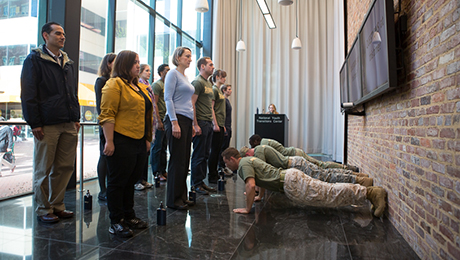By Lauren Ingeno
George Washington University faculty and staff members stood at attention—shoulders pulled back, hands shaped into light fists—wincing as Mitch Bent shouted orders in their faces.
“Drink water! Now! Be the first to finish! Hurry…up!” yelled Mr. Bent inside a floor-to-ceiling glass window room at the National Veterans Center, 2013 H Street, on Friday afternoon.
The group of 12 men and women standing in formation lunged for their black canteens and fumbled to unscrew their caps.
“Sip. Don’t gulp. Quicker!” Mr. Bent barked, his voice echoing off of the walls.
Unlike Mr. Bent, those following orders on Friday had never served in the Armed Forces. But for a few hours, they received a taste of military culture.
The Ribbon Project is a five-hour, immersion-style training program hosted by the George Washington Office of Military and Veteran Student Services, designed to bridge the gap in communication between GW faculty and staff with military personnel and student veterans.
When participants walked in the door they were told to drop their bags and take off their jackets. They were organized into a formation of two straight lines and remained standing for the duration of the training.
“I don’t think anyone really knows what they are getting themselves into when they come in here, and it is a little bit of a shock,” said Mr. Bent, a junior in the Elliott School of International Affairs who served two tours in Iraq. “But that’s kind of the point. Because for a lot of us going into the military, that first time you step off that bus and people are getting in your face, it is a real shock.”
Mr. Bent and two other student veterans led participants through the life cycle of a service member—from completing basic training to living in a combat zone, returning back home and adjusting to civilian life. Throughout each “phase” of military life, the student veterans gave personal accounts of their experiences.
They recounted how they surrendered their individuality during basic training, joining 200 other men or women who looked, walked and talked exactly alike.
After being handed his dog tags—two pieces of metal that would help identify his “unrecognizable” body if he was killed in combat—Mr. Bent said he was given “block after block of instruction on how to be.”
“I was no longer Mitchell Bent from Farmington, New Mexico, high school graduate of 2004. I wasn’t a skateboarder. I wasn’t a mountain climber. I was addressed by my last name, or private or ‘hey you.’ That went on for weeks,” Mr. Bent said. “I was broken down and then built back up.”
The purpose of these stories is to simulate a service member’s evolution through each of these phases, said Michael Ruybal, associate director of Military and Veteran Student Services. In that respect, the program at GW is unique, he said.
“Before you walk through that door, you’re a civilian. When we bring you in here, we put you in a military situation. Then we send you back out into the civilian sector. It’s the same way a service member transitions,” Mr. Ruybal said. “So, it gives a very quick, brief glimpse into what it’s like to live that life.”
Since 2009, GW has participated in the Yellow Ribbon Program, a provision of the Post-9/11 GI Bill that allows colleges and universities to voluntarily enter into an agreement with the Department of Veterans Affairs to fund tuition expenses that exceed the maximum base pay amount.
The program fully funds undergraduate student veterans as well as full tuition costs for law and most master’s degrees. Additionally, GW provides support for veterans through multiple programs, campaigns and organizations.
But that doesn’t mean the transition from service member to college student is an easy one.
Being 10 years older than most of his classmates, Mr. Bent said it was difficult to relate to and work with his peers at GW, some of whom took their education less seriously than he did. It was also difficult for him to surrender his leadership role and follow the rules of his instructors.
During the second portion of the Ribbon Training Project, faculty and staff were able to talk to the veterans in a more relaxed, one-on-one environment about issues regarding the transition from the military to higher education.
Mr. Bent said he hopes that faculty and staff can use those stories to “better understand the military mindset,” so they can not only communicate more effectively with veterans, but can also learn to utilize their leadership skills and knowledge in the classroom.
Donna Betts, an assistant professor and acting director of the GW Art Therapy Program, took part in the Ribbon Project Training. She and a group of GW researchers are developing a computer software program that will enable military service members to create graphic novels on a computer, in order to help relieve stress and cope with post-traumatic stress disorder.
As part of her study, Dr. Betts will bring in military service members to test out the computer program before it is used in clinical trials.
“Since we will be working with military service members, we felt it was important to come to this training to help sensitize us to the military culture,” Dr. Betts said. “The exercises today were kind of a reality check—this is what these guys deal with all day, every day. What better way to learn about somebody’s culture than to at least have a window into it? ”
The next Ribbon Project training session will take place on Nov. 22, and sessions will be held throughout the academic year. Faculty, staff and students can sign up here. While faculty and staff member have been the first to take part in the training, Mr. Ruybal said he thinks the Ribbon Project could be beneficial for traditional students and he hopes more get involved.


